

On Sunday morning, Steve G. and I boarded the VIP bus
bound for the Banana Creek Viewing Area -- just 3.2 miles from Pad B. As
the countdown stalled and the weather failed to improve, it became apparent
that the launch would be delayed. Making our way back to the bus, we talked
for the first time about possibly missing this launch. Later that evening
I started packing. My flight home was scheduled for tomorrow evening. Endeavour
had to launch Monday morning!
 D
When
we arrived at Cape Canaveral’s Hanger A-E the morning of February 10th,
1993, some of the team members had already staked their claim on office
space with cardboard nameplates. This would be the first stop for the Superfluid
Helium On-Orbit Transfer (SHOOT) payload on its way to Kennedy Space Center.
The whole room was buzzing -- smiles, handshakes, and "high-fives" abound.
At 9am the conference room was packed; most of the faces were familiar,
but many were new to us. We went around the room, stating our name and
purpose for being there. Then the managers proceeded with the formal briefings,
protocols and schedules. All of this was fine, but I still couldn’t wait
to see the star of the show arrive.
D
When
we arrived at Cape Canaveral’s Hanger A-E the morning of February 10th,
1993, some of the team members had already staked their claim on office
space with cardboard nameplates. This would be the first stop for the Superfluid
Helium On-Orbit Transfer (SHOOT) payload on its way to Kennedy Space Center.
The whole room was buzzing -- smiles, handshakes, and "high-fives" abound.
At 9am the conference room was packed; most of the faces were familiar,
but many were new to us. We went around the room, stating our name and
purpose for being there. Then the managers proceeded with the formal briefings,
protocols and schedules. All of this was fine, but I still couldn’t wait
to see the star of the show arrive.
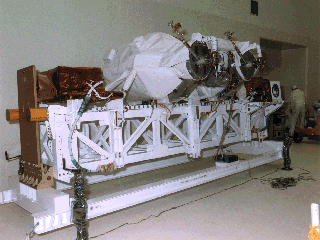 D
D
The call came just before noon. The truck carrying
the experiment consisting of two large liquid helium-filled tanks and a
complex array of tubing, valves, and sensors was only 20 miles away. It
slowly maneuvered its way to the back of the building near the entrance
to the clean room facility. When the truck door was opened, it was apparent
that the payload had shifted during transit. Fortunately, a thorough inspection
revealed no damage to any flight hardware! The rest of the afternoon was
spent gently moving the two ton baby from truck to truck. Soon after the
flatbed truck was in the clean room, the overhead crane hooked-up to the
lifting straps, and delicately placed the payload on the floor. This would
be SHOOT’s home for the next couple of weeks.
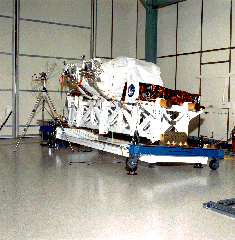 D
D
Our first problem came as we were removing protective
wrapping from the payload. One of the technicians noticed a hand valve
partially opened, and quickly closed it. However, an ice plug had already
formed inside the high flow vent line, and the dewar would have to be warmed
up to allow the frozen air to melt. This is a risky procedure, because
the temperature must rise from 4.2 Kelvin (K)(-269 C or -452 F) to about
80 K (-193 C, -315.7 F). The increasing pressure inside the tank could
cause the emergency burst disks to rupture, setting us back weeks in an
already tight schedule. Skillfully, our team crossed this hurdle with no
damage to hardware. The ongoing job now was to keep the dewars cold by
periodically filling with liquid helium.
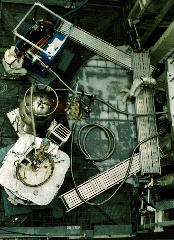 D
D
I was a member of Cryogenic Servicing Team #1, Steve
G. was assigned to Team #2, and Jim T. worked with either team, alternating
with the other two project scientists. As we had come to find out, every
cryogenic servicing job was different in setup. In the Hanger A-E clean
room, the payload sat horizontally, with plenty of open space to manipulate
the 2-3 inch diameter, vacuum-jacketed, flexible steel lines. Each line
was 20-30 feet long, requiring support to relieve stress on the supply
dewar siphon and flight dewar fill and vent ports. When the payload moved
to the Vertical Processing Facility (VPF) in late February, the servicing
took on a new complexity.
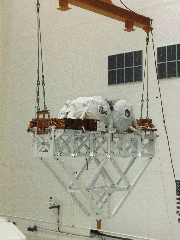 D
Now
secured to the Hitchhiker bridge, the SHOOT payload was mounted to support
beams 75 feet above the VPF floor. KSC personnel surrounded the payload
with sturdy platforms and scaffolds to allow continued access. In addition
to our cryogenic safety gloves, face masks, and aprons, the VPF required
full clean room bunny suits, as well as tethering of all tools and equipment.
The lines were somewhat easier to stage because there were numerous support
beams, rails, and overhead platforms to tie to. The dewars were now sitting
vertically, so the time between fills increased from several days to several
weeks. Despite these obstacles and constraints, the servicing went very
well. We even conducted successful transfer tests with our assigned astronauts,
Mission Specialists Janice Voss and Jeff Wisoff. At the beginning of April,
SHOOT was loaded into the Payload Canister, a clean, environmentally controlled
container the size of the shuttle bay.
D
Now
secured to the Hitchhiker bridge, the SHOOT payload was mounted to support
beams 75 feet above the VPF floor. KSC personnel surrounded the payload
with sturdy platforms and scaffolds to allow continued access. In addition
to our cryogenic safety gloves, face masks, and aprons, the VPF required
full clean room bunny suits, as well as tethering of all tools and equipment.
The lines were somewhat easier to stage because there were numerous support
beams, rails, and overhead platforms to tie to. The dewars were now sitting
vertically, so the time between fills increased from several days to several
weeks. Despite these obstacles and constraints, the servicing went very
well. We even conducted successful transfer tests with our assigned astronauts,
Mission Specialists Janice Voss and Jeff Wisoff. At the beginning of April,
SHOOT was loaded into the Payload Canister, a clean, environmentally controlled
container the size of the shuttle bay.
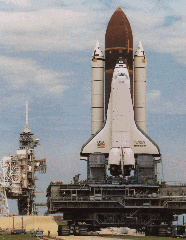 D
D
The Payload Canister was transported to Launch Complex
39 Pad B, where it was attached to the Payload Changeout Room (PCR). There,
while maintaining the cleanliness level, the payload was transferred to
the PCR, and the Canister was taken away. The PCR rendered its own challenges,
with tighter working space, less tie points to secure the lines, and stricter
tool control than the VPF. In addition, headsets were needed to communicate
with team members during servicing because of the high background noise
and line-of-sight impediments. Again, the team prevailed, completed one
successful fill after another as delays in the shuttle launches kept us
waiting. In the middle of April the Endeavour rolled up to Pad B, and the
SHOOT payload was installed into the bay. With the launch scheduled for
June 20th, Steve, Jim, and I headed to Kennedy to participate in the most
crucial servicing work of the project.
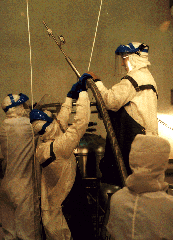 D
To
prepare for the last cryogenic procedure before flight, the low temperature
top-off, the flight dewars and the 1000 liter dewars were topped off with
liquid helium. The low temperature top-off requires pulling a vacuum on
the liquid helium tanks, which lowers the temperature to less than 2 K.
On Tuesday, June 15th, we began 12 hour shifts to monitor the huge, noisy
pumps that were pumping on the dewars. That Thursday morning we were ready
to begin the low temperature top-off at about 10:30am. Suddenly, a fire
alarm sounded, and a voice over the PA ordered everyone out of the PCR!
We ran down seven flights of stairs, still fully dressed in our clean room
bunny suits, into the 90 degree sunshine. We hurried over to our boxcar
office at the base of the pad, waiting for instructions from the Pad Leader.
After a few moments, the false alarm was cleared, and we returned to the
PCR. After that little scare, the low temperature top-off went without
a hitch.
D
To
prepare for the last cryogenic procedure before flight, the low temperature
top-off, the flight dewars and the 1000 liter dewars were topped off with
liquid helium. The low temperature top-off requires pulling a vacuum on
the liquid helium tanks, which lowers the temperature to less than 2 K.
On Tuesday, June 15th, we began 12 hour shifts to monitor the huge, noisy
pumps that were pumping on the dewars. That Thursday morning we were ready
to begin the low temperature top-off at about 10:30am. Suddenly, a fire
alarm sounded, and a voice over the PA ordered everyone out of the PCR!
We ran down seven flights of stairs, still fully dressed in our clean room
bunny suits, into the 90 degree sunshine. We hurried over to our boxcar
office at the base of the pad, waiting for instructions from the Pad Leader.
After a few moments, the false alarm was cleared, and we returned to the
PCR. After that little scare, the low temperature top-off went without
a hitch.
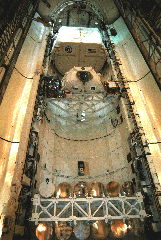 D
D
The final task before clearing out of the PCR was
the payload closeout, which includes making electronic connections, adding
thermal blankets, removing ground support parts, and lock wiring bolts.
Everything proceeded smoothly through the afternoon, until a 4 inch piece
of lock wire was lost near the payload. With the launch in danger of slipping,
everyone available searched around and below the payload for the braided
steel wire. After a couple hours, I found the wire resting on the reflective
blanket covering the SHOOT Auxiliary Power Unit (APU) box. With that issue
closed, the pad was cleared, and we awaited the launch of STS-57.
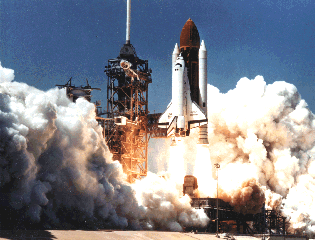 D
D
We were at the Spaceport bus stop at 7am. The weather
looked much better today than Sunday. We staked out our spots at the viewing
area. I set up my camcorder just behind the short fence in front of the
bleachers. The countdown continued. Every countdown hold time we passed
brought clapping and cheers from the spectators. Finally, the last ten
seconds were counted off, and the Endeavour lifted off the pad. We waited,
then the sound and vibration from the solid rocket boosters hit the viewing
area. It was the most spectacular event I've ever witnessed. The feeling
was indescribable, made even sweeter by the fact that something we worked
on with our hands was going for the ride!
Return to SHOOT page
|

|